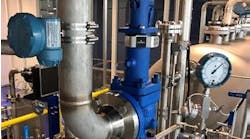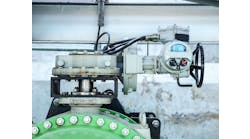The 24-in. characterized-seat ball valve was one of the minority of instrument “things” in the plant that constituted a single point of failure, bringing all production to a halt immediately if, for example, it failed to open. Like many continuous process plants, an outage would mean a day or more of lost production, unusual wear and tear on equipment and catalyst, and increased risk for operators forced to engage in many non-routine procedures. That it was the anti-surge valve for the facility’s un-spared turbine-driven air compressor was another reason to be mindful of its health—damaging this turbomachinery through an unmitigated compressor surge event could mean weeks instead of days of downtime.
It stood to reason that operators were skittish about its health when they noticed it didn’t consistently respond to small position setpoint changes. One click, two clicks of the mouse: no movement. Each click was less than a half-percent change in setpoint; even if you climbed up to the top deck of the reactor where it was located, you would be challenged to visually detect such a small move. Maybe such a large valve shouldn’t be expected to respond to such a small change, but if the valve was sticking, was it going to jump and overshoot the desired position, upsetting the process?
Operations entered a work request to pull this valve for overhaul in the next outage, months away. It’s not small and being high in the structure, requires a large crane to bring it down and reinstall it. Wouldn’t it be great, one imagines, if we could precisely determine this valve’s condition and confirm it needed an overhaul?
The operators could even detect their setpoint changes weren’t getting the valve to move in response was evidence they had position feedback from a smart positioner. Controller I/O capable of HART or fieldbus communication can be employed to display the valve position “as seen by” its positioner. Having been incorporated into MMI graphics for years, operators were accustomed to observing whether a valve was moving to its desired position, sticking or unstable. Valve position feedback—if reliable—is interesting and useful information for routine operations as well as control systems troubleshooting.
Valve positioners were among the first instruments to become “smart,” i.e., microprocessor-based and capable of self-diagnosis. Even before smart positioners were commonplace, experts could be engaged to hook up sensors to laptops and assess (offline) whether a given valve was healthy or not. This particular valve’s positioner had been smart for nearly two decades. You would think that a critical “thing” such as this would get some measure of routine inspection—"Let ’s see how it’s doing today”—whether it was weekly or even monthly. Indeed, there are probably a number of critical valves that warrant some routine attention, control valves whose health and performance have an immediate impact on continuous operation. But who’s excited to tinker with critical positioners that are functioning adequately?
If you’re fortunate enough to have a system that can communicate with smart devices, consider an investment in a late-model positioner, like the Fisher FieldVue DVC6200 and its kin, that have been on the market for a few years. One can license access to features like process diagnostics: while on process, the DVC can automatically monitor for a number of trigger events—a sustained deviation between setpoint and measured position would be one example, whereupon the positioner itself gathers data from its numerous internal sensors—supply pressure, actuator pressures, position sensors, drive signals, etc.—at 100 millisecond intervals. The HART version will store this data in a buffer for a minute or two after the trigger event, while the fieldbus version will store the data for both two minutes preceding and two minutes after. These records are preserved and can be examined offline, and sent to a specialist at your representative or the factory.
Even without a compatible host system, diagnostic data from critical valves can be retrieved using a handheld device like the Emerson AMS Trex handheld communicator, or a laptop/tablet running Fisher ValveLink, Metso Valve Manager, Masoneilan ValVue, Flowserve ValveSight, or compatible software from your favorite control valve supplier. If you’re looking to get started on utilizing “intelligent” devices to avert unplanned outages and better prepare for scheduled shutdowns, deploying smart valve positioners on critical valves is a great place to start.






